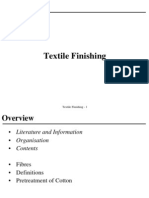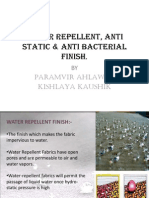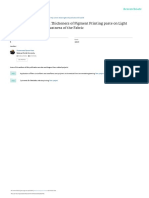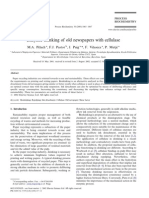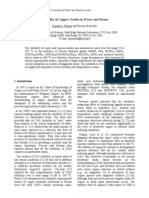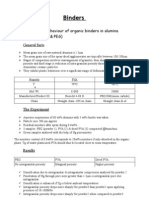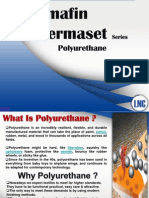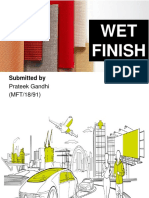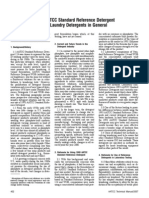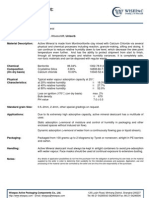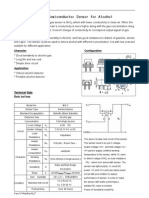0 ratings0% found this document useful (0 votes)
79 viewsDevelopment of Antistatic Finish in Text
Development of Antistatic Finish in Text
Uploaded by
ANURAG JOSEPHCopyright:
© All Rights Reserved
Available Formats
Download as PDF, TXT or read online from Scribd
Development of Antistatic Finish in Text
Development of Antistatic Finish in Text
Uploaded by
ANURAG JOSEPH0 ratings0% found this document useful (0 votes)
79 views6 pagesCopyright
© © All Rights Reserved
Available Formats
PDF, TXT or read online from Scribd
Share this document
Did you find this document useful?
Is this content inappropriate?
Copyright:
© All Rights Reserved
Available Formats
Download as PDF, TXT or read online from Scribd
Download as pdf or txt
0 ratings0% found this document useful (0 votes)
79 views6 pagesDevelopment of Antistatic Finish in Text
Development of Antistatic Finish in Text
Uploaded by
ANURAG JOSEPHCopyright:
© All Rights Reserved
Available Formats
Download as PDF, TXT or read online from Scribd
Download as pdf or txt
You are on page 1of 6
Int. J. Adv. Sci. Eng. Vol. 2 No.
2 69-74 (2015) 69 ISSN 2349 5359
Development of antistatic finish in textiles
Usha Sayed*, Kanchan Sharma
Department of Fibres and Textile Processing Technology,
Institute of Chemical Technology, Nathalal Parekh Marg, Matunga, Mumbai-400019, India
ABSTRACT: Static electricity is a common problem in the world of polymers, which themselves act as electrical
insulators. Static electricity causes the surfaces to pick-up dust or to stick to each other. A more dangerous
consequence is its sudden discharge which, for example, can lead to a dust explosion. This paper suggests the
remedies such as the addition of an antistatic agent to the base polymer. This lowers surface resistivity to such a
level that the static charge can easily get dissipated.
KEY WORDS: Antistats, Plasma, Nano finish, Synthetic fibre.
© 2015 mahendrapublications.com, All rights reserved
INTRODUCTION value below 1014 Ω/sq. by using an antistatic additive,
The primary role of an antistatic agent is to prevent conductive fillers, plasma, flame or corona treatment,
generation of electricity within the different textile conductive coatings or metal deposition [3].
materials. Static electricity is generally developed either due ANTISTATIC TEXTILE:
to extra electron or due to deficiency of electron, these Antistatic finishes are generally applied when the antistatic
inequalities can be generated by separation or friction of two nature of the substrate is to be maintained for a longer time,
materials or through induction processes particularly due to antistatic can be applied to the textile material either by
contact with ionized air. These inequalities are either due to coating, finishing or as an addition in the polymer dope
separation or by friction of two material or through itself. Antistatic agents are added to the bulk of the polymer
induction processes, and is particularly due to contact with forming a pathway for the charges to flow from the polymer
ionize air. Static electricity can be generated during surface to ground.
processing; transportation and handling are also in the final External antistatic agents are applied externally from
end use of the textile material. Once the charge is generated, solutions to the textile surface through a variety of methods
dissipation of the charge is dependent on the nature of the including padding baths, spraying, plasma grafting, vapor
materials involved and the surrounding conditions [1]. deposition, coating, finishing etc. External antistatic agents
have hydrophobic and hydrophilic functionalities in their
This phenomenon affects the polymer, mainly due to the fact molecular structure. The hydrophilic part orients itself
that they have very high volume resistivities (pv) in the towards the air and promotes the absorption of moisture,
range 1014- 1018 Ω-cm and are therefore good insulators. resulting in better ion mobility and dissipation [4].
Depending on the materials involved as well as the ambient
conditions such as relative humidity, the induced charge NON-DURABLE FINISHES:
generation can reach up to 30,000-40,000 volts. Non-durable antistatic agents are used to treat textile
substrates that will not undergo repeated or any laundering
The accumulated electrostatic voltage can be discharged via in their lifetime. These include products like conveyor belts
an arc or spark by contact with another material possessing and driving cords.
sufficiently different potential. There are many causes
connected with the problem of static electricity. Electrostatic More common non-durable antistatic finishes are anionic in
discharge in the polymer industry is very common and nature and include compounds like esters of phosphoric
hence the role of electrostatic agents is very important [2]. acid, alkyl phosphates, ethoxylated secondary alcohols,
In production: clinging effects during sheet extrusion or glycerol mono- and distearate, sodium alkyl sulfonates,
during fibre spinning can occur. neutralized alcohol phosphate, sorbitan monolaurate and
In the packaging industry: problems with the loading of sorbitan monooleate etc [5].
bags with dry materials, particularly powders, damage The important industrial processing methods of applying
of packaged goods due to electrostatic discharge. amine antistats include extrusion, calendaring, immersion,
Transportation: problems with feeding liquids or dipping, compounding, blow molding, sheet extrusion,
powders through plastic tubes or funnels, as well as spraying, surface printing etc. It also includes non-ionic
liquids in plastic bags or bottles compounds, these are mostly ethoxylated fatty esters,
Accumulation of dust on plastic articles, which is not alcohols and alkylamines. The ethoxy groups provide good
only a nuisance, but also a problem during the storage hydrogen bonding.
of end-use articles and causes electrostatic discharge
[2]. DURABLE ANTISTATIC FINISHES:
In order to overcome these problems the most practical Conventional durable antistatic finishes are obtained by
solution is to lower the surface resistivity of the plastic to a forming a functional polymer network on the surface of the
*Corresponding Author: ushatxt@gmail.com
Received: 18.09.2015 Accepted: 04.12.2015 Published on: 14.12.2015
Usha Syed & Kanchan Sharma
International Journal of Advanced Science and Engineering www.mahendrapublications.com
Int. J. Adv. Sci. Eng. Vol. 2 No.2 69-74 (2015) 70 ISSN 2349 5359
substrate. The polymer network has hydrophilic groups that polymer only after altering the atomic layer of the polymer.
assist in the dissipation of any charge. The polymers can be Low temperature plasma technique is regarded as an
formed prior to application on fabrics or they can be formed environmentally friendly process because no chemicals are
on the surface of the substrate itself [6]. involved or released in the treatment. LTP only does etching
and oxidation on the surface of textile material, hence
MIGRATING & NON-MIGRATING ANTISTATIC surface properties are modified along with those which
ADDITIVES: associates with the surface characteristics [16,17]. Short
Excellent antistatic properties with strong ultrasonic time exposure to plasma could greatly reduce the charge
welding performance and high moisture permeability can be density of the fabric. For the further improvement in the
obtained using antistatic additives. Potential applications antistatic behavior of polyester fabric treatment with Poly
include packaging for pharmaceutical and cosmetic vinyl alcohol can be done after application of low
products, electrical components, food and drink as well as temperature plasma.
pallet packaging [10].
ANTISTATIC NANO FINISHES:
Synthetic fibers such as Nylon and polyester absorb less
water because of which these are prone to static charge
accumulation. It has been reported that nano sized TiO2,
ZnO whiskers, nano antimony-doped tin oxide (ATO) and
silane nanosol can also be used to impart antistatic
properties to synthetic fibers. TiO2, ZnO and TiO2
nanoparticles are electrically conductive in nature and can
Figure 1Migration of internal antistatic additives in a polymeric be used to dissipate the static charge in these fibers [18].
matrix
Modifying textiles by numerous nano-sized particles (TiO2,
Non-permanent antistatic agents are typically based on
silica, iron oxide, zinc oxide, etc.) is one approach for
hygroscopic compounds with a low molecular weight, such
enhancing and/or imparting new functionalities to various
as glycols, sulphonates or amides. They are more-or-less
types of fibres and forms of textile materials, i.e. improved
incompatible with the base polymer and therefore migrate
thermal stability and flame-retardancy [19,20] water
to the surface once the final product is formed. The result is
repellent properties [21,22] easy to clean properties [23-
the formation of a thin surface layer, which, with sufficient
25]. These protective properties, e.g. UV and EMR shielding
air moisture, absorbs water to become conductive. The
[26,27], antimicrobial activity [27,28] etc. Various methods
speed of migration to the surface will depend on the
are being employed in order to create multifunctional nano-
chemical structure of the molecules. Fig-1The antistatic
textiles and are generally classified into three groups as
effect is not permanent, as the content of the antistatic agent
described below: [29].
in the polymer will decline after time. Permanent antistatic
agents are usually based on polymers [11]. during (i) Inclusion of nanoparticles within the fibres,
processing they form a co-continuous network within the (ii) Chemical grafting of nanoparticles onto the surface of
polymer which they need to render antistatic. Consequently fibre, and
it is functional almost immediately and without activation (iii) Functional nano coating of textiles' surfaces.
time and the network formed allows negligible migration to In order to prepare nano coated textile materials, there are
take place. This brings with it two major benefits namely: certain distinct methodologies including coating by the
The antistatic effect remains over time, if the agent is dispersion of well-defined Nano-oxides [20,26,28],
not consumed. functionalization by inorganic sol gel coating [19, 22, 29, 31],
The effect limits itself to the intended, specific layer of the layer by layer deposition method [32-33] and
the package. The agent does not have a negative effect embedding the nanoparticles on the fibres' surfaces by
on the packaging content. Even if the material is used crosslinking agents such as water-based polysiloxane
for decoration the adhesion properties of the surface is emulsion [34] and (poly) carboxylic acid [21,35]. These
not effected [12]. developed technologies should offer desirable levels of
Common permanent antistatic agents are based on material functionality and furthermore, should meet
polyamide or polyesters and are therefore incompatible with environmental and economic demands.
polyolefin, which may have a negative effect on processing
From amongst a number of nanoparticles of various sizes,
but, the newly-developed permanent antistatic agent based
shapes, and structures, inorganic TiO2 has received
on an ethylene ionomer chemistry such as Entira™ ASMK400
increased interest over recent years for the functionalizing
from DuPont eliminates this problem [13].
of textile materials because of its excellent optical
APPLICATION OF PLASMA ON POLYESTER: properties, good thermal stability, long-term lifetime, lack of
To improve antistatic behavior of polyester fabric low toxicity, and relatively low-cost, as proved in [24, 26, 28, 30].
temperature plasma technique can also be used. As we know Moreover, nano-sized TiO2 particles show high
Plasma treatment has been used in the aerospace, photocatalytic activity when applied onto the surfaces of
semiconductor, and electronic industries for years in different materials, because they have a relatively large
cleaning, etching and surface treatment for various materials surface area per unit mass and volume, which facilitates
[14, 15]. diffusion of the surface, and generates charge-carriers under
light irradiation [25]. These so-called self-cleaning or easy-
Using this technique modification of some polymeric surface cleaning textile materials provide promising applications for
can be done. New properties can be incorporated in the
Usha Syed & Kanchan Sharma
International Journal of Advanced Science and Engineering www.mahendrapublications.com
Int. J. Adv. Sci. Eng. Vol. 2 No.2 69-74 (2015) 71 ISSN 2349 5359
medical and protective purposes, domestic textiles, technical Table 1 Surface resistivity and practical use of antistatic finished
textiles, interior decorative coverings, the furnishings of textiles [39]
public buildings, filters, etc. Surface resistivity range Assessment
In addition, due to its capability of absorbing UV and (Ω)a
transmitting visible light, TiO2 is already being employed as 1 × 106 – 1 × 108 Very good
a UV-filtering substance in sunscreen cosmetics, as well as 1 × 108 – 1 × 109 good
for the production of sun protective clothing against the sun.
[27,36]. 1× 109 –1× 1010 Satisfactory
1× 1010– 5× 1010 Limit of sufficiencyb
LABORATORY TESTING OF ANTISTATIC FINISH:
Temperature and relative humidity are the important s>5 × 1010 Insufficient
parameters to be kept in control for the evaluation of
antistatic finish, relative humidity affects the antistatic a Normal climate with 65 % relative air humidity.
property of the fabric since the resistivity of the fibre b Needfor more control and detailed specification
depends on its moisture content. The higher the relative Table 2 Field intensity half-life time and practical use of
humidity, the higher the moisture content and the lower the antistatic finished textiles [39]
resistivity.
Mostly electrostatic test methods can be divided in three Field intensity half-life time Assessment
main categories: (s)a
measuring the cling time 0–0.3 Very good
the electrical resistance or the electrostatic voltage 2-Jan Good
or charge
often as half-life time 3-Feb Satisfactory
Quantitative results can be obtained with AATCC Test 3-Feb Sufficientb
Method 115: ‘Electrostatic clinging of fabrics: Fabric to metal
>3 Insufficientc
test’, also known as the ‘cling’ test. A fabric that has been
electrically charged in a repeatable manner by rubbing is aNormal climate with 65 % relative air humidity.
bNeed for more control and detailed specification.
placed next to a grounded inclined metal plate. Any residual
cAbsolute times for change of charge are an additional helpful
electrical charge causes the fabric to cling to the plate. The
criterion for the selection of antistats.
time required for the fabric to be released from the plate is
Fig 2 The amount of antistatic agent used for these tests
measured. Shorter the cling time, better the antistatic
varies in between 10 - 30 wt. % In polyethylenes, the desired
properties.
low surface resistance and required low static decay time
However, fabric-to-metal cling times are not directly related could be achieved with additive levels between 15 and 20
to fabric-to-body cling times [37]. wt% (measured at 50% RH)[41].
AATCC Test Method 76: ‘Electrical resistivity of fabrics’ is The newly developed ethylene ionomer chemistry is in
used to measure the surface resistivity of fabrics (units are conjunction with a variety of polymers, ranging from
ohm/square). The voltage drop across a ring electrode polyethylene (PE) and polypropylene (PP) to ethylene-
system is used to determine the fabric’s resistivity. A copolymers (EMA and EVA) to engineering polymers (ABS
resistivity value of 1011 ohm/square or lower is considered and polyamide). Polymer processing methods employed
to be indicative of a fabric with negligible static propensity. included blown film, extrusion blow moulding, injection
[38] moulding and roll mill mixing [42].
Table 1 shows a common assignment of surface resistivity The additive even when applied to the thin outer layer of
values to practical usage of the finished textiles at 65% polymer gives the performance of the complete surface
relative humidity (corresponding to DIN 54 345-1: during testing. The new permanent antistatic agent
‘determination of electrical resistance’). maintains most of its performance down to humidity levels
A charge generation test for carpets is given in AATCC Test of approximately 30%RH [43].
Method 134: ‘Electrostatic propensity of carpets’. The body Properties Test method Units
voltage of a person wearing shoes with standard neoprene
or leather soles is measured as they walk across a carpet. Density ISO 1183-1987 Kg/m2
The maximum voltage after 30–60 s is recorded. Again, the Melt flow Rate ISO 1133-1997 g/10min
lower the voltage, the better the antistatic properties [40].
Melting point DSC C
Properties that are measured include surface resistance,
Vicat softening
static decay and dust pick-up after generating static ISO 306-1994 C
point
electricity on the finished piece. The latter was measured by
Tensile strength ISO 527-2-1993 type 1BA
rubbing the testing object against a cotton cloth before MPa
@ break bars, 2mm thick
bringing it in contact with Bonita Flakes (fish flakes).
Tensile
ISO 527-2-1993 type 1BA
elongation %
bars, 2mm thick
@break
Usha Syed & Kanchan Sharma
International Journal of Advanced Science and Engineering www.mahendrapublications.com
Int. J. Adv. Sci. Eng. Vol. 2 No.2 69-74 (2015) 72 ISSN 2349 5359
stiffness ASTM D747 MPa weight and cost advantages. Durable antistatic chemicals
and the fabrics containing conductive materials can be
Hardness, Shore D ISO868-1985 - replaced by conducting polymers, functional materials like
Surface resistivity conductive nanomaterials, carbon nanotubes, graphene etc.
At 23 C X30% RH Ω/sq. Ω/sq. [47], these are some new developments in the field of
At 23 C X50% RH antistatic finishing of textiles. New technique like ecofriendly
plasma treatment at low temperature is being given to
Figure 2 Test performed to check effect of additives as polyester to modify the polymeric surface to impart new
permanent antistatic agent
functional properties to the polymer and it involves no
chemicals and also no chemical is released. It is also
TROUBLESHOOTING FOR ANTISTATIC FINISHES interesting to have electrically conducted nanoparticles on
AND PARTICULARITIES: synthetic fibres to impart good antistatic behavior and much
The performance of most antistatic finishes depends on the of the recent research is in this direction [48].
kind of fibre and sometimes also on the kind of fabric
(anisotropic behaviour, for example, different in warp and Finally, there has been an increase in facilities capable of
weft directions). Although wool is a hydrophilic fibre, wool manufacturing bicomponent and indeed tricomponent
fabrics often are highly charged, caused by the strong fibres. This not only increases the possibility of having
friction between the wool scales. splittable fibres and thereby instantly creating a lot more
surface area, but also gives greater potential for creating
For optimal performance uniform penetration for fabric is multicomponent fibres which could potentially have
important while applying antistatic finish. The use of wetting conductive components incorporated into the fibre. Such
agents in the finish formulation is recommended. Pad, spray fibres would find use in applications for either generating or
and kiss-roll applications are preferred method of suppressing static electrification.
application. In exhaust method cationic antistats are suitable
Spray and foam applications are enabled by the low add-on
values (mostly about one or a few percent on weight of
fibre). With identical add-on, padding leads to lesser affects
than does foam application [44].
This is probably caused by the higher concentrations of
antistatic agents on the fibre surface by the foam application.
On the other hand, the durability of the padded finish might
be greater.
Some of the potential side effects of the use of antistatic
finishes include wear comfort (no clinging and a pleasant
skin contact caused by hydrophilicity), soil release
properties, increased soiling with dry soil, yellowing after
exposure to heat and impaired crock fastness of textiles
dyed or printed with disperse dyes. The permanence of
antistatic finishing effects to repeated washings, even at only Figure 3 Triboelectric Tester
40°C, is limited, as the mechanical stress of the washing
process decreases the antistatic performance significantly.
So the washing and the abrasion resistances of antistatic
finishes are crucial [45].
DEVICES USED TO MEASURE STATIC CHARGE
GENERATION AND DISSIPATION OF CHARGES:
To access testing is being done under controlled
environmental condition such as humidity and temperature.
Some devices are as follows which are used to measure
static charge generation and dissipation of charges. Tribo
Electric Tester (Fig-3) is used to measure static charge and
dissipation on polymeric two-dimensional surfaces using
simple repeated contact and separation, Tribocharge Tester
(Fig-4) device is used to measure static charge and
dissipation on two-dimensional surfaces using repeated
rubbing cycles and the Contact and Rubbing Testers (Fig-5)
is a device used to measure static charge and dissipation on Figure 4 Tribocharge Tester
yarn surface) [46].
CONCLUSION:
The literature has revealed that development in conducting
polymeric materials such as polyaniline, polypyrole and
polythiophene has been evolving due to their durability,
Usha Syed & Kanchan Sharma
International Journal of Advanced Science and Engineering www.mahendrapublications.com
Int. J. Adv. Sci. Eng. Vol. 2 No.2 69-74 (2015) 73 ISSN 2349 5359
15. Yokoyama, T., Kogoma, M., Moriwaki, T., Okazaki, S.,
1990, The mechanism of the stabilization of glow
plasma at atmospheric pressure. J. Phys. D 23, 1125–
1128.
16. Chongqi, M., Shulin, Z., Huang, Gu., 2010 Anti-static
charge character of the plasma treated polyester filter
fabric, School of Textiles, Journal of Electrostatics,
68,111–115
17. Kanazawa, S., Kogoma, M., Moriwaki, T., Okazaki, S.,
1998, Stable glow plasma at atmospheric pressure. J.
Phys. D 21,838–840.
18. Tsai, P.P.Y., Wadsworth, L.C., Roth, J.R., 1997, Surface
modification of fabrics using a one-atmosphere glow
discharge plasma to improve fabric wettability. Textile
Figure 5 contact and Rubbing Testers Res. J. 67, 359–369.
REFERENCES: 19. Alongi, J., Ciobanu, M., Malucelli, G., 2011. Cellulose, 18,
1. Markus C. G., Ernst, M., 1992, Permanent antistatic 167.
additives: new developments. Plastics Additives & 20. Sfiligoj Smole, M., Hribernik, S., Veronovski, N., Kurečič,
Compounding, p.20-26 M., Stana Kleinschek, K., 2011. in:Reddy, B., (Ed.),
2. Williams, J. B.,Geick, K. S., Falter, J. A., Hail L. K., 1995, Advances in Nanocomposites—Synthesis,
Annu .Tech.Conf.- Soc.Plast.Eng, 53rd, 3610-3614 Characterization and Industrial Applications, InTech,
3. Pailthorpe M., David S K., 2003, ‘Antistatic and soil (Available from: http://www.intechopen.com/books/
release finishes,’ in Textile Finishing, D Heywood (ed.), advances-in-nanocomposites-synthesis-
Bradford, Society of Dyers and Colourists, 308–336. characterization-and-industrialapplications/
4. Seyam, A.M., Oxenham, W., Theyson, T., Antistatic and electrokinetic-properties-of-nanocomposite-fibres).
electrically conductive finishes for textiles, Functional 21. Gashti, M. P., Alimohammadi, F., Shamei, A., 2012. Surf.
Finishes for Textiles p.513-553 Coat. Technol, 206, 3208.
5. Pionteck & Wypych, 2007, Schindler & Hauser, 2004. 22. Textor, T., Mahltig, B., 2008. Appl. Surf. Sci. 256, 1668.
6. Jhosi, M., Nanotechnology: A New Route to High 23. Bozzi, A., Yuranova, T., Kiwi, J., 2005. J. Photochem.
Performance Textiles., india, p.p 279 280 Photobiol. A 172, 27.
7. Kang, H.M., Yoon, T.H., Vanooij, W, J., 2006, Enhanced 24. Wu, D., Long, M., Zhou, J., Cai, W., Zhu, X., Chen, C., Wu, Y.,
adhesion of aramid tire cords via argon plasma etching 2009. Surf. Coat. Techno, 203, 3728.
and acetylene plasma polymerization. J. Adhes. Sci. 25. Yuranova, T., Mosteo, R., Bandara, J., Laub, D., Kiwi, J.,
Technol. 20, 1155–1169. 2006. J. Mol. Catal. A 244, 160.
8. Kan, C. W., Yuen,C.W.M., Chan, C.K., Lau, M.P., 2007, 26. Fakin, D., Veronovski, N., Ojstršek, A., Božič, M., 2012.
Effect of surface treatment on the properties of wool Carbohydrate Polymer, 88, 992.
fabric. Surf. Rev. Lett. 14, 559–563. 27. Nimittrakoolchai, O.U., Supothina, S., 2009. Res. Chem.
9. Joshi, M., 2008, The Impact of Nanotechnology on Intermed. 35, 271.
Polyesters, Polyamides and other Textiles, ‘Advances in 28. Veronovski, N., Hribernik, S., 2010. J. Adv. Microsc. Res.
Polyesters and Polyamides, Woodhead Publishing, Ltd. 5, 56.
Cambridge, UK. 29. Mahltig, B., Haufe, H., Böttcher, H., 2005. J. Mater. Chem.
10. Seyam, A.M., Cai, Y., Wendisch, B. and Kim, Y.K., 2008, 15, 4385.
Disc-shaped fiber web formation with controlled fiber 30. Veronovski, N., Andreozzi, P., La Mesa, P., Sfiligoj Smole,
orientation using electrostatic forces: Theoretical M., 2010. Surface Coating Technology, 204, 1445.
analysis and experimental verifycation, J. Text. Inst., 99 31. Uddin, M.J., Cesano, F., Scarano, D., Bonino, F., Agostino,
(4), pp. 375 – 383. G., Spoto, G., Bordiga, S., Zecchina, S., 2008. J.
11. Rychkov , A.A., Cross, G.H. and Gonchar, M.G., 1992, ‘ A Photochem. Photobiol. A, 199, 64.
method for discriminating between “external” and 32. Goncalves, G., Marques, P.A.A.P., Pinto, R.J.B., Trindade,
“internal” processes leading to voltage decay from T., Neto, C.P., 2009. Compos. Science Technology, 69,
electrets in humid conditions ’, J Phys. D: Appl. Phys. , 25 1051.
( 3 ), pp. 522 – 524. 33. Liu, J., Wang, Q., Fan, X.R., 2012. J. Sol–gel Sci.
12. Liang, J., Liu, B, Q., 2005, Intromission of water-repellent Technology, 62, 338.
and hydroscopic properties simultaneously to PP by 34. Dastjerdi, R., Montazer, M., Shahsavan, S., 2009. Colloids
plasma discharge method. Chin. J. Polym. Sci. 23, 83–92. Surface, A 345, 202.
13. Massines, F., Rabehi, A., Decomps,P., Gadri, R.B., Segur, 35. El-tahlawya, K.F., El-bendaryb, M.A., Elhendawyc, A.G.,
P., Mayoux, C., 1998, Mechanisms of a glow discharge at Hudson, S.M., 2005. Carbohydrate Polymer, 60, 421.
atmospheric pressure controlled by dielectric barrier. J. 36. Wu, C.H., Shr, J.F., Wu, C.F., Hsieh, C.T., Mater. J., 2008.
Appl. Phys. 83, 2950–2957. Process. Technology, 203, 326.
14. Kanazawa, S., Kogoma, M., Moriwaki,T., Okazaki, S., 37. AATCC Technical Manual, American Association of
1998, Stable glow plasma at atmospheric pressure. J. Textile Chemists and Colorists, Research Triangle Park,
Phys. D 21, 838–840. NC, 1999.
Usha Syed & Kanchan Sharma
International Journal of Advanced Science and Engineering www.mahendrapublications.com
Int. J. Adv. Sci. Eng. Vol. 2 No.2 69-74 (2015) 74 ISSN 2349 5359
38. Sello S. B., Stevens C.V., 1984. Handbook of Fiber Science
and Technology, Vol. II, Chemical Processing of Fibers
and Fabrics, Functional Finishes, Part B, Levin, m., Sello
S. B., (eds), Marcel Dekker, New York, 291–315.
39. Goebel I, Cognis/Henkel, 1989 and 2003.private
communication.
40. Pailthorpe, M., David, S. K., 2003. ‘Antistatic and soil
release finishes,’ in Textile Finishing, D Heywood (ed.),
Bradford, Society of Dyers and Colourists, 308–336
41. Bhattacharyya, A., Joshi, M., 2011, Co-deposition of Iron
and Nickel on Nanographite for Microwave Absorption
through Fluidized Bed Electrolysis. International
Journal of Nanoscience, 10 (4-5), 1125 – 1130.
42. Zhang, Z., Liang, H.J., Hou, X. H., Yu, Y.J., 2001, Plasma
surface modification of poly (maramide) fabric for
adhesion improvement to fluorosilicone rubber. J.
Adhes Sci. Technol. 15,809–822.
43. Rogers, J. L., Antistatic agents, In Modem Plastics
Encyclopedia 1984-1985; Agranoff, J. Ed.; McGraw-Hill
Inc.: New York, 1984; Vol. 61; pp. 107-110.
44. Seyam, A.M., Oxenham, W., Theyson, T., Antistatic and
electrically conductive finishes for textiles, Functional
Finishes for Textiles p.513-553
45. Elbadawi A. M., 2000. ‘Foam application: the future of
textile wet processing’, International Textile Bulletin,
46(2), 70–74.
46. Mahall, K., 1972. ‘Die permanent antistatische
Ausrüstung heute’, Deutscher Färberkalender, 76, 332–
351.
47. Seyam, A. M., Oxenham, W., Theyson T., Antistatic and
electrically conductive finishes for textiles, 549-550.
48. Alessio, B., Maximilian, D., Pierandrea, L. N., & Piero, B.,
2007. Synthesis and characterization of zinc oxide
nanoparticles: application to textiles as UV-absorbers. J
Nanopart Res.
Usha Syed & Kanchan Sharma
International Journal of Advanced Science and Engineering www.mahendrapublications.com
You might also like
- Tomb of Annihilation - The HomebreweryDocument15 pagesTomb of Annihilation - The HomebreweryЛёша ЛозицкийNo ratings yet
- Nano Finishing of TextilesDocument31 pagesNano Finishing of TextilesHillol135100% (1)
- Textile Finishing - 1Document15 pagesTextile Finishing - 1fetufekci3525100% (1)
- Synthesis and Evaluation of Direct Blue Dyes 7 Mansoor IqbalDocument14 pagesSynthesis and Evaluation of Direct Blue Dyes 7 Mansoor IqbalMansoor IqbalNo ratings yet
- Final DrawingsDocument253 pagesFinal DrawingsBui Duy Thanh100% (1)
- Fuji Af-300 MiniDocument127 pagesFuji Af-300 MinimvhernanNo ratings yet
- Types of Antistatic FinishesDocument2 pagesTypes of Antistatic FinishesSadaf SweetNo ratings yet
- Antistatic Agent2Document27 pagesAntistatic Agent2Kishen DeepakNo ratings yet
- Water Repellent, Anti Static & Anti BacterialDocument20 pagesWater Repellent, Anti Static & Anti BacterialApurv SinhaNo ratings yet
- International Standard: Textile Fabrics - Determination of Resistance To Surface Wetting (Spray Test)Document6 pagesInternational Standard: Textile Fabrics - Determination of Resistance To Surface Wetting (Spray Test)yok patchnakan100% (3)
- Water Repellent FinishesDocument5 pagesWater Repellent FinishesKevin MeonkNo ratings yet
- (N) Guide To Selecting Surface-Treated Pigments and Powders 5 PDFDocument16 pages(N) Guide To Selecting Surface-Treated Pigments and Powders 5 PDFEllen GurNo ratings yet
- Atomic Force Microscope (AFM) : Block Copolymer Polymer BlendDocument71 pagesAtomic Force Microscope (AFM) : Block Copolymer Polymer Blendsvo svoNo ratings yet
- Altranol GRDocument22 pagesAltranol GRL.N.CHEMICAL INDUSTRYNo ratings yet
- New Dimensions of SoftnessDocument9 pagesNew Dimensions of SoftnessEugene PaiNo ratings yet
- Yellowing of Textiles - Anti Phenolic YellowingDocument20 pagesYellowing of Textiles - Anti Phenolic YellowingL.N.CHEMICAL INDUSTRYNo ratings yet
- Rhodopsin Dyes For Polyamide by RDNDocument96 pagesRhodopsin Dyes For Polyamide by RDNSaidul KarimNo ratings yet
- Binderpapr PDFDocument11 pagesBinderpapr PDFAbel Abrham100% (1)
- Deinking With CellulaseDocument5 pagesDeinking With CellulaseKulwinder KaurNo ratings yet
- 10 5923 J Textile 20120106 03 PDFDocument9 pages10 5923 J Textile 20120106 03 PDFsonia aliNo ratings yet
- An Overview of Polyester and Polyester Dyeing Part-4: ..... Previous Part Next Part....Document5 pagesAn Overview of Polyester and Polyester Dyeing Part-4: ..... Previous Part Next Part....Ronak Joshi100% (1)
- Dyeing of Polyamide FibersDocument19 pagesDyeing of Polyamide Fibersrajdewaan100% (1)
- Importance of Sequestering Agent in Textile ProcDocument6 pagesImportance of Sequestering Agent in Textile ProcHrishikesh DhawadshikarNo ratings yet
- 491palmer Copper Oxide SolubilityDocument6 pages491palmer Copper Oxide SolubilityauriumrsNo ratings yet
- C Colours-Merged PDFDocument90 pagesC Colours-Merged PDFvinodhiniNo ratings yet
- Antistain RDL 2 - SDSDocument10 pagesAntistain RDL 2 - SDSchoton_iii0% (1)
- Project - Aramid FibersDocument22 pagesProject - Aramid FibersMohammed Anass EL MAROUANI100% (1)
- Texturized PETDocument2 pagesTexturized PETGauri PuranikNo ratings yet
- Binders: 1. Compaction Behaviour of Organic Binders in Alumina Ceramics (PVA & PEG) General FactsDocument13 pagesBinders: 1. Compaction Behaviour of Organic Binders in Alumina Ceramics (PVA & PEG) General FactsPranav Kumar100% (1)
- Phenolic YellowingDocument7 pagesPhenolic YellowingImtiaz Ahmed100% (1)
- Classifications of Synthetic Organic AdhesivesDocument6 pagesClassifications of Synthetic Organic AdhesivesJanna Jaiya MeowNo ratings yet
- Formulation of Print Paste Using Natural and Indigenous Thickener - MaizeDocument4 pagesFormulation of Print Paste Using Natural and Indigenous Thickener - MaizeFathi MustafaNo ratings yet
- ISO 105 E03-1997 Textiles. Tests For Colour Fastness. Colour Fastness To Chlorinated Water (Swimming Bath Water)Document12 pagesISO 105 E03-1997 Textiles. Tests For Colour Fastness. Colour Fastness To Chlorinated Water (Swimming Bath Water)Sumanto100% (1)
- Textile-Enhancers - PDF MomentiveDocument17 pagesTextile-Enhancers - PDF MomentiveGokhan RamiNo ratings yet
- Pigment Printing of TextilesDocument45 pagesPigment Printing of Textilesyadi haryadiNo ratings yet
- OrganocatalysisDocument15 pagesOrganocatalysisan9005931No ratings yet
- Disperse or Polyster DyesDocument12 pagesDisperse or Polyster DyesMohammed Atiqul Hoque ChowdhuryNo ratings yet
- JSDC Volume 99 (1983) 183-191Document9 pagesJSDC Volume 99 (1983) 183-191Kaio MaxNo ratings yet
- Presentacion Lpr76 Oct. 2014Document84 pagesPresentacion Lpr76 Oct. 2014KinhNguyenNo ratings yet
- Photo InitiatorsDocument15 pagesPhoto InitiatorsJuan Antonio Tito Esp CalNo ratings yet
- Permafin - Hydrophilic Water Soluble Polyurethanes For Textiles.Document12 pagesPermafin - Hydrophilic Water Soluble Polyurethanes For Textiles.L.N.CHEMICAL INDUSTRYNo ratings yet
- Alkaline Weight Reduction of Polyester FabricsDocument1 pageAlkaline Weight Reduction of Polyester FabricssateeshgoreNo ratings yet
- Brochure Home Care Dissolvine m40 Ms Global enDocument20 pagesBrochure Home Care Dissolvine m40 Ms Global entony tangNo ratings yet
- Stabitex ETRDocument5 pagesStabitex ETRMuhammad Aasim HassanNo ratings yet
- Hydrophilic Silicones NewDocument11 pagesHydrophilic Silicones NewL.N.CHEMICAL INDUSTRYNo ratings yet
- File Polymer Family TreeDocument1 pageFile Polymer Family TreeDhimas KLSNo ratings yet
- Pmma Conv-Look1Document77 pagesPmma Conv-Look1KristineNo ratings yet
- Sika® Coolcoat: Product Data SheetDocument3 pagesSika® Coolcoat: Product Data SheetमधुNo ratings yet
- TCP - Ii FinishesDocument82 pagesTCP - Ii FinishesNabarupa Bose100% (1)
- WET Finish ES: Submitted byDocument34 pagesWET Finish ES: Submitted byprateek gandhiNo ratings yet
- Lyoprint DT-CS PDFDocument5 pagesLyoprint DT-CS PDFLambo SunNo ratings yet
- PolyesterDocument7 pagesPolyesterkgaviolaNo ratings yet
- Thermoplastic PolyurethaneDocument4 pagesThermoplastic PolyurethanepepeNo ratings yet
- Disperse Dyes For Printing On PolyesterDocument2 pagesDisperse Dyes For Printing On PolyesterFathi Mustafa100% (1)
- SequesterentsDocument10 pagesSequesterentsKetan GandhiNo ratings yet
- Silicone Compatibility TestDocument2 pagesSilicone Compatibility TestDyeing DyeingNo ratings yet
- Testing BookletDocument8 pagesTesting BookletveselieNo ratings yet
- Polymer Adhesives Note - DR Akinsiku PDFDocument15 pagesPolymer Adhesives Note - DR Akinsiku PDFGlory UsoroNo ratings yet
- Aatcc DetergentDocument2 pagesAatcc DetergentOliver Everett Espino100% (1)
- TCP-Finishing NotesDocument37 pagesTCP-Finishing NotesKuldeep Yadav100% (1)
- Alcoprint RD-HT Ex BradfordDocument37 pagesAlcoprint RD-HT Ex Bradfordyadi haryadiNo ratings yet
- Heat Setting of FabricsDocument5 pagesHeat Setting of FabricsFathi MustafaNo ratings yet
- Bio-Based SolventsFrom EverandBio-Based SolventsFrançois JérômeNo ratings yet
- Bloomsbury Fashion Central - Sportswear, Knit, and PrintDocument23 pagesBloomsbury Fashion Central - Sportswear, Knit, and PrintANURAG JOSEPHNo ratings yet
- The Social Innovation Trends 2020 2030 ReportDocument38 pagesThe Social Innovation Trends 2020 2030 ReportANURAG JOSEPHNo ratings yet
- Youth Colour Forecast A W 22 23Document25 pagesYouth Colour Forecast A W 22 23ANURAG JOSEPHNo ratings yet
- IJRAR1944343Document14 pagesIJRAR1944343ANURAG JOSEPHNo ratings yet
- Journal 81Document33 pagesJournal 81ANURAG JOSEPHNo ratings yet
- Arts and Crafts of Jummu and KashmirDocument8 pagesArts and Crafts of Jummu and KashmirANURAG JOSEPHNo ratings yet
- Pashmina Shawl: - A Traditional Way of Making in KashmirDocument5 pagesPashmina Shawl: - A Traditional Way of Making in KashmirANURAG JOSEPHNo ratings yet
- The Embroidery Artisans of The Kashmir Valley - Cultural Imports ADocument10 pagesThe Embroidery Artisans of The Kashmir Valley - Cultural Imports AANURAG JOSEPHNo ratings yet
- Potential Sectors of State Economy: An OverviewDocument66 pagesPotential Sectors of State Economy: An OverviewANURAG JOSEPHNo ratings yet
- A Study On The Different Delightful Craft Work inDocument4 pagesA Study On The Different Delightful Craft Work inANURAG JOSEPHNo ratings yet
- Methodological Holism and IndividualismDocument3 pagesMethodological Holism and IndividualismANURAG JOSEPHNo ratings yet
- 8.03 Carriage of Rice in BulkDocument19 pages8.03 Carriage of Rice in BulkRoken Zgoul100% (2)
- Factors Affecting Crop ProductionDocument71 pagesFactors Affecting Crop ProductionMc Wilson DecenaNo ratings yet
- SyloidDocument2 pagesSyloidJitendra YadavNo ratings yet
- The Indoor Environment Handbook - How To Make Buildings Healthy and Comfortable-Philomena BluDocument325 pagesThe Indoor Environment Handbook - How To Make Buildings Healthy and Comfortable-Philomena BlutatimoyaNo ratings yet
- PsycrometryDocument24 pagesPsycrometryFaisal Ahmmed FahimNo ratings yet
- C Series Product Guide PDFDocument112 pagesC Series Product Guide PDFVictor PATIÑONo ratings yet
- Climatology FinalDocument148 pagesClimatology Finaldellaishere03100% (1)
- MAnual AC Inverter Series - enDocument40 pagesMAnual AC Inverter Series - ensilviutudose2003No ratings yet
- Moisture Conversion TableDocument1 pageMoisture Conversion Tableniranjan570No ratings yet
- Performance Investigation On Refrigeration and Air Conditioning Systemswith Multi-EvaporatorDocument8 pagesPerformance Investigation On Refrigeration and Air Conditioning Systemswith Multi-EvaporatorJohn Fredy Muñoz BuitragoNo ratings yet
- Element Pipe 5Document11 pagesElement Pipe 5Akie MontepiaNo ratings yet
- Hygrothermal AssessmentDocument9 pagesHygrothermal AssessmentGeorge LazarNo ratings yet
- 46 - Technical Data Sheet - Active MineralDocument1 page46 - Technical Data Sheet - Active MineralKavindaNo ratings yet
- MQ3Document3 pagesMQ3George JosephNo ratings yet
- Toefel ReadingDocument11 pagesToefel ReadingalwafiNo ratings yet
- Water Engineering PDFDocument40 pagesWater Engineering PDFamir mulaniNo ratings yet
- Moisture Transport in Silica Gel Packed Beds II Experiemental StudyDocument42 pagesMoisture Transport in Silica Gel Packed Beds II Experiemental StudyGrumpy Cat ZhangNo ratings yet
- BEB34303 S221 Final Project Assessment BriefDocument5 pagesBEB34303 S221 Final Project Assessment BriefSyed MuhammadNo ratings yet
- Lecture CH I - MCE 419 - Gas MixtureDocument22 pagesLecture CH I - MCE 419 - Gas MixtureRaji RidwanNo ratings yet
- Structural Design Solutions PDFDocument13 pagesStructural Design Solutions PDFChary Glez MaldonadoNo ratings yet
- Sagem MF-9626 Installation ManualDocument90 pagesSagem MF-9626 Installation ManualQualitetnNo ratings yet
- Cary Eclipse: Pre-Installation ManualDocument34 pagesCary Eclipse: Pre-Installation Manualsoumendra ghoraiNo ratings yet
- Jotun Epoxy Filler: Technical Data Sheet Application GuideDocument5 pagesJotun Epoxy Filler: Technical Data Sheet Application GuidekajaqcNo ratings yet
- Packing House Operations Fruits and VegetablesDocument16 pagesPacking House Operations Fruits and Vegetablesronalit malintad0% (1)
- Lecture 10 - Drying TheoryDocument49 pagesLecture 10 - Drying TheoryKing starNo ratings yet
- Banishing The Black ArtsDocument5 pagesBanishing The Black Artscklcat1437No ratings yet
- Synthesis and Characterization of Polyimide-Polysiloxane Segmented Copolymers For Fuel Cell ApplicationsDocument12 pagesSynthesis and Characterization of Polyimide-Polysiloxane Segmented Copolymers For Fuel Cell Applicationskelen.floresNo ratings yet


